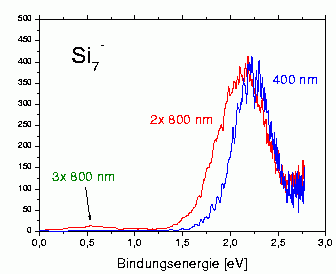Ultrafast processes
Study of ultrafast dynamics using fs-Lasers
Sodium clusters
The collective excitation of metal clusters and especially of sodium
clusters has been studied intensively both by experiment and theory. The
optical absorption spectra of size selected sodium clusters, which are
dominated by the collective excitation, have been measured among others
by our group.
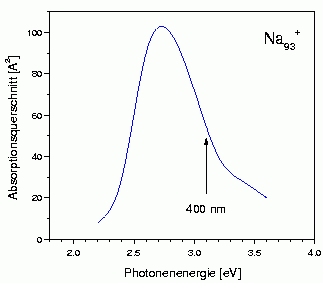
Despite the huge amount of data concerning this collective excitation
now available there are still a number of important open questions:
- What is the lifetime of the collective excitation?
- How does it decay, how fast does the energy gets equally distributed within the electron system, what is the timescale for the coupling to the ion lattice?
- How harmonic it the plasmon excitation, is it possible to excite higher modes?
As in these experiments one cannot exclude an influence of the surface or the matrix (at least for smaller particles with 1000 atoms or less), we have started to do experiments on free size selected sodium clusters. First results are shown here.
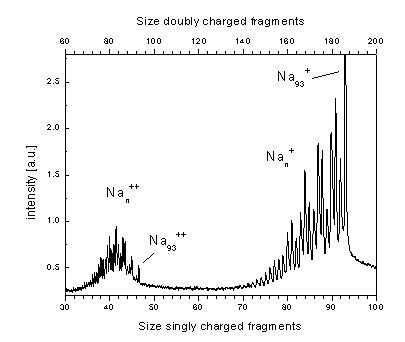
If the cluster is irradiated by a sufficiently strong fs-laser pulse, it will absorb several photons. This leads to a strong heating of the electron gas and to the emission of one or several electrons. In the case of Na93+ this leads to the appearance of doubly charged (and few triply charged) fragments in the fragment mass distribution. Higher charge states are unstable and will undergo coulomb explosion.
In the case of Na345+ one can observe higher charge states up to fivefold positively charged fragments.
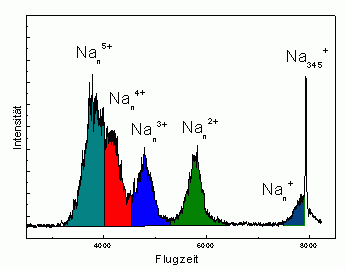
In order to study the electron emission process in more detail we have measured the kinetic energy distribution of the electrons emitted by the sodium clusters.
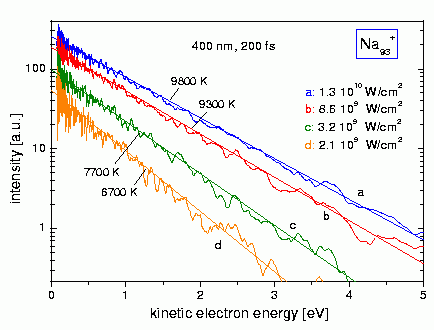
Currently we are trying to measure the cooling rate of the electron gas ("electron-phonon-coupling") by time resolved (pump-probe-)experiments. Interesting questions here are the dependence on clusters size and on its temperature.
Furthermore experiments using much shorter and tunable laser pulses are planned to look for non-thermal electron emission, that is for direct ionization by multi-photon absorption.
Silicon clusters
The reason to study silicon clusters by fs-spectroscopy is in principle the same as for metal clusters: one would like to obtain information about the timescales of the different possible electronic relaxation processes inter-band and intra-band relaxation processes due to electron-electron-and electron-phonon-coupling).
The technique of choice here is the pump-probe photoelectron spectroscopy: by absorption of a photon from a first pulse an electron gets excited into a higher state; absorption of a photon from the second pulse than leads to ionization. The measurement of the kinetic energy of the electron allows one (in principle) to determine the binding energy of the excited electron at the time of the second laser pulse. By variation of the delay time between the two pulses one can therefore directly follow the relaxation of the electron. In the case of small clusters additionally to this electronic relaxation one will of course observe wave packet dynamics of the atoms on the potential surface of the excited state as well, and it is very interesting to study the development of this molecular behavior towards bulk-like electron-phonon-coupling as a function of size.
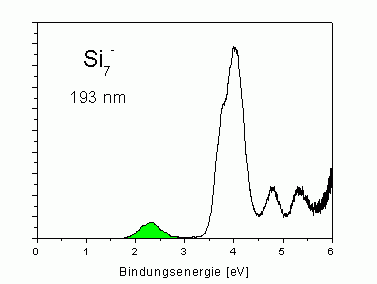
In the case of the 800 nm fs-pulse (where the ionization is a two-photon-process) the peak is broader and shifted to smaller binding energies. This hints at a change of the geometrical structure of the cluster between the two absorption events.
Another peak can be seen at 0.5 eV binding energy. This is a so called ATI-effect (above threshold ionization): the electron which after the absorption of two photons already is in a continuum state absorbs another photon. This effect is well known for atoms, but there occurs only at laser intensities of about 1014 W/cm2 or more. In the case of clusters obviously only a much lower intensity is needed (here about 1011 W/cm2).
